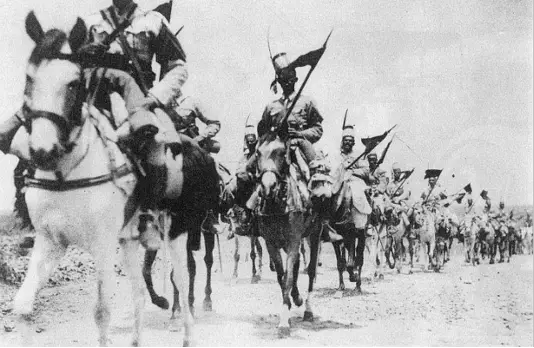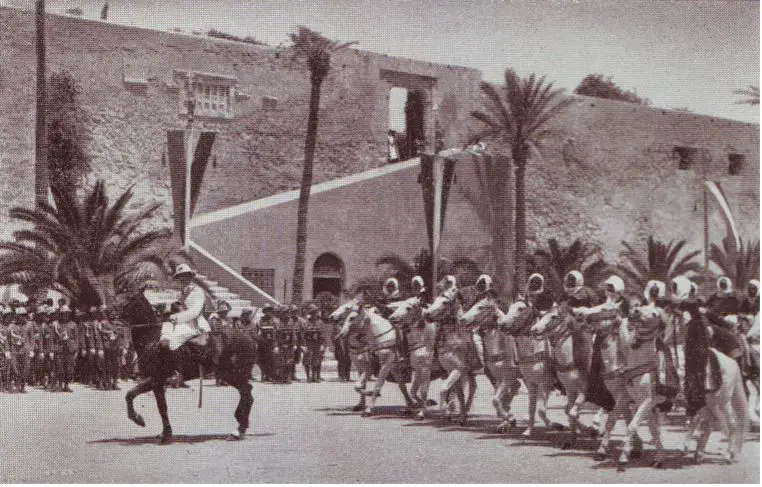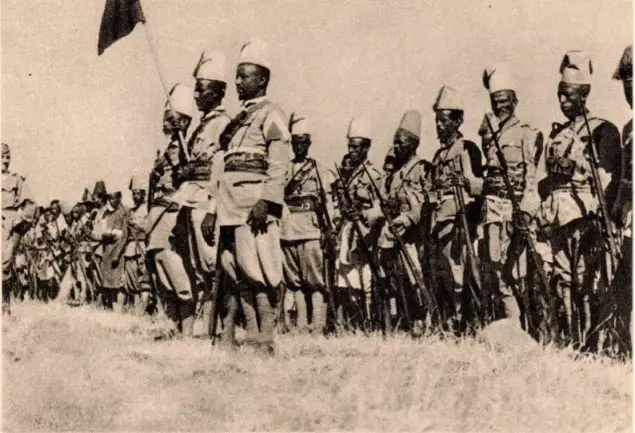During its history, the kingdom of Italy had acquired a certain number of colonies in Africa which corresponded to today’s territories of Eritrea, Somalia and Libya. Ethiopia was conquered in 1936 but remained in Italian control only for five years.
Since the end of the 19th century, these territories provided colonial troops that were constantly used by the Italians until the early stages of WW2.
Eritrea, land of the Ascari
Eritrea was the oldest of Italian colonies, established in 1885. Here, the recruitment of local troops began immediately, they were organized in irregular bands (Basci Buzuk) and their main task was controlling territory and fighting bandits.
A few years later the Italians began to raise the first “regular” battalions, better armed and trained than the Basci Buzuk. These men were called “Ascari” a Turkish word widespread in East Africa which meant “Soldier”. Those who were recruited by the Royal Carabiniers (Military Police) were called Zaptiè and served in policemen duties.
Soon, artillery and cavalry units joined the ranks of the Ascari units and later participated in the first Italo-Abyssinian war, which culminated with the Italian defeat at Adowa where roughly 2.000 Ascari fell.
Between 1912 and 1935, a total of 26 Ascari battalions were raised and fought in counterinsurgency operations in Somalia and Libya. In 1935, when Mussolini decided to invade Ethiopia, the Italian Army raised two entire Ascari divisions, grouped in the Eritrean Army corps under General Pirzio Biroli. These were small divisions consisting of 5 infantry battalions and an artillery Group. Beside them, two cavalry squadrons joined the fight against Ethiopia. These were renowned as the “Penne di Falco” (Hawk feathers) for their singular hat’s ornament.

Figure 1 Penne di Falco during the invasion of Ethiopia

Figure 2 Libyan Spahis parading in the 1930s

Figure 3 Ascari Infantrymen from Eritrea
Indigenous personnel were also used on Italian warships since the navigation in the Red Sea required men who knew those waters and who could act as interpreters. To counter the threat of piracy and the Ottoman Navy, in 1902 the Italian Navy prepared some armed sambuks, whose crews were made up of naval Ascaris. Enlistment was voluntary among Eritreans, Somalis and then among Libyans aged between 16 and 30.
Somalia
The establishment of the Italian colony of Somalia followed Eritrea by a few years and the recruitment of local soldiers began quite soon to address the security needs of the colonizers. Thus, the Benadir Guard Corps was established. The colony could not provide the same amount of men as Eritrea did, but nevertheless, a certain number of Somalian colonial troops were raised in the following decades. During the long-lasted counterinsurgency operations in Libya, after the end of WW1, at least three companies of Somalia troops were deployed at a time.
Worthy to mention are the “Dubats”, men purposely tasked to defend the border from bandits coming from across the border. When the war with Ethiopia began, a few battalions of Somalian troops were raised and joined General Graziani’s forces that advanced from the south-east.
Libya
The provinces of Tripolitania and Cyrenaica were conquered in 1912, taken from the Ottoman Empire, and became the new Italian colony of Libya. Already after the end of the war, the Italians recruited a few thousand local troops, which were however depleted in the subsequent counter-guerrilla operations. Italy took a long time to repress the Senussi rebels and fully get control of the colony, this was in fact only achieved in 1932 after a very bloody and costly campaign.
Only after the pacification of Libya, the Italians were able to effectively recruit Libyan units for controlling the colony and serving overseas. An entire division of Libyan troops was raised and participated in the invasion of Ethiopia. Besides the infantrymen, Libya provided a colourful range of mounted troops, these were mainly of three types:
– Savari: Libyans trained and equipped by the Italians, riding horses.
– Spahi: Libyans fighting in their traditional way dressed in their peculiar clothes and own horses.
– Meharisti: Libyans riding dromedaries (of the mehari race) used for scout duties.
During the war in Ethiopia, the famous “Devil Commander” Amedeo Guillet commanded a squadron of Libyan Spahis.
In March 1938, Italo Balbo, Governor of Libya and former head of the Regia Aeronautica, established the Paratrooper School of Libya (Campo Scuola Paracadutisti della Libia). The objective was to develop and train a rapid reaction force, to be used against local guerrilla fighters. In April, the 1° Regiment Fanti dell’ Aria (Air infantrymen) was established, listing 300 men, mostly Libyans from the colonial divisions led by Italian officers. The regiment was subsequently dismantled and only the 1st Battalion Fanti dell’ Aria remained, together with the “National” Paratrooper battalion, formed by Italian volunteers.
Colonial troops in WW2
With the escalating tension of 1939, culminating with the start of the Second World War, Italian colonial troops were mobilized and saw actions in the African campaigns until 1941.
In 1940, the indigenous troops in East Africa amounted to roughly 200,000 men while Italian nationals were around 50,000. They were organized in around 100 distinct battalions, often grouped in Brigades, and came mostly from Eritrea and Somalia but there were also some brigades recruited among Ethiopians in the last years.
Their equipment was generally poorer than Italian regular troops, in some cases they were provided with the standard Carcano rifles but often received Austro-Hungarian equipment from WW1 (Manlicher rifles and Schwarzlose machineguns) and in some cases also the very old Vetterli Vitali rifles.

Figure 4 A propaganda picture depicting the death of Unatù Endisciau
Describing the battles of the East Africa campaign is beyond the scope of this article, but we can say that most of the colonial troops, especially the Eritrean Ascaris, fought bravely and in many cases, like at the Battles of Keren and Culqualber, fought to the last men together with the Italian nationals. At Culqualber, Unatù Endisciau, a Zaptiè of Ethiopian origin took part in the last stand defence of his unit’s position. Once the strongpoint was about to be overrun, he escaped carrying his unit battle flag and made it to the Italian rear lines where he died from the wounds received. He was the first of two indigenous soldiers to receive the Gold Medal for Military Valor. The second man to receive such decoration was Ibrahim Farag Mohammed, an Ascari who had joined the Italian navy in the 1920s. He was on board the destroyer Manin which headed for an almost suicidal mission against Port Sudan. When the ship sank, he found himself in the water on a raft but soon he gave away his post to a wounded Italian and he later died in the water.
The other theatre that saw considerable participation of colonial troops was North Africa, at least in the early stages. When Marshall Graziani invaded Egypt in September 1940, he had two Libyan divisions in his 10°Army. These two large units were annihilated in the course of Operation Compass and the same fate faced the few hundred Libyan paratroopers mentioned earlier. For the rest of the North African campaign, a few colonial troops remained in service for secondary roles, far from the frontline.
Sources
Esposito G. (2022). Italian colonial troops 1882-1960).
Santangelo A. (2020). La caduta dell’impero fascista.
Longo L.E. (2005). La campagna Italo-Etiopica 1935-1936.
